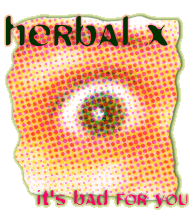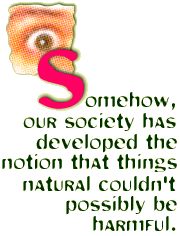LIVING & TRAVEL

by Ben Klipstein
WEB RESOURCES
Crossfire!: the makers of Herbal Ecstacy respond to the FDA allegations.
Florida Bans Pills that Emulate Ecstasy: an article about Florida's decision in the April 26th edition of USA Today.
Hyperreal: a comprehensive web resource that covers all aspects of rave culture.
E is for Ecstacy: the complete text of the book by Nicholas Saunder.
Herb Discussion Board: post your questions about ephedrine and other herbs at this site.
Federal Drug Administration: the official web site of the FDA
It's four in the morning at a rave in midtown Manhattan. Partygoers, pale and bleary-eyed, have been dancing for six hours straight after taxing their bodies with energy-boosting drugs. The intimidating queue that reached around the block two hours ago is gone, leaving only a few diehard clubbers to gyrate on the floor to the frenetic techno beats booming over the sound system.
The remaining ravers are dependent on an array of substances including Ecstasy (MDMA), Speed, Cocaine, and Special K to boogie their way through the night. But soon these toxic treats will wear off, and euphoria and excitement will crash into restlessness and disenchantment. And while most youngsters understand the illegality and questionable purity of these street drugs, their consumption continues en masse.
So why aren't they using one of the much-hyped legal alternatives, which can be purchased at a store? The substitutes proudly display their ingredients and promise "100% natural, tingly and floaty mind experience." Could something all natural really be that bad?
At the rave, the answer depends on who you talk to. Some have tried these natural "dietary supplements," others eschew them. But the general consensus seems to be that the herbal drug alternatives called "Ecstacy" (purposely misspelled on this product), "Cloud Nine" and "Ultimate Xphoria" (they possess almost identical ingredients) are reserved for times when the real stuff is not readily available. Based on the word of the ravers, that's not too often.
You've surely heard of these ubiquitous new products, riding high on the new "herbal wave" sweeping the nation. Like the vitamin craze of the 1970's, herbs have been touted in the 90's as everything from cancer cures to libido boosters, as well as alternatives to illegal chemical substances. What most don't understand though, is that herbs are not exempt from causing bodily harm.

This misguided belief may be responsible for the death of Peter Schlendorf, a 20-year-old Long Islander who slugged down eight "Ultimate Xphoria" pills while on spring break in Florida. Schlendorf went into cardiac arrest a few hours after ingesting the colorful tablets, only three more than the recommended dose.
Florida and Nassau County, NY have subsequently outlawed " Herbal Ecstacy", citing the unpredictable effects of its main ingredient, Ma Huang. Ma Huang, a Chinese herb used throughout history as a mild stimulant, is a fancy name for Ephedra, from which the drug Ephedrine is derived. Available at most truck stops and convenience stores as little as a year ago, production of chemically pure Ephedrine has recently been banned in the US in the wake of some very bad publicity.

That loophole is a 1994 law which classifies all herbs as being outside the jurisdiction of the F.D.A., so long as the ingredients are openly disclosed. Which they are, on each and every box of Herbal Ecstacy. Exotic names such as Tibetan Ma Huang, Wild Brazilian Guarana, Chinese Black Ginseng, German Wild Ginkgo Biloba, and African Raw Cola Nut adorn the pyramidal package, packed tight with self-congratulatory literature touting the substance's "miraculous effects."
According to Global World Media, the Venice, California company that produces Herbal Ecstacy, users can expect "euphoric stimulation, highly increased energy levels, tingly skin sensations, mood elevations, and increased sexual sensations," approximately two hours after ingesting a mere five pills on an empty stomach.
In an informal test of the validity of these claims, these instructions were closely followed by a small group of curious young adults, in order to best experience the assortment of bodily sensations promised by the manufacturers. After purchasing two pyramids of "Ecstacy" for $40(!), we began our investigation. The funky-looking blue tablets were consumed at approximately 8:30 PM.
9:00 PM
Upon dosing, there was a marked feeling of excitement amongst the
participants in anticipation of what was to come. It was short lived,
however, as the Ephedra- and Caffeine-packed tablets took unkindly to the
empty stomachs; the only tingly feelings reported were those of nausea. Of
course, only thirty minutes had elapsed, a full hour and a half before the
expected onset of euphoria.
9:30 PM
Thirty minutes later, our faith was almost restored when one participant
noticed a feeling of well-being coming on, but it turned out to be merely a
lull in her nausea.
10:17 PM
Subjects debated whether to visit the local watering hole in order to help
"coax" the Ecstacy into action.
10:47 PM
The group finally felt the full effects of the Herbal Ecstacy, which
everyone quickly agreed were somewhat unpleasant. There were tingles, all
right. Hair was reported to attain a conductive quality, sending shivers
into the scalp upon being touched. Chills shot from limb to limb, and skin
did indeed become more sensitive. But an antsy talkativeness soon
descended on the group as subjects noticed their pulse rates speeding up.
This did lead to a short-lived mild state of euphoria, but any effects besides increased perspiration were for the most part intangible, and varied widely between participants. All agreed that they were stimulated by the Herbal Ecstacy, but in a manner that induced anxiety and sleeplessness for up to eight hours after ingestion.

When taking any mind-altering substance there is chance for adverse effects, either mental or physical. Weighing these possibilities is necessary before ingesting any substance from alcohol to Ecstasy.
Back at the rave, it's 6 AM, and the last of the clubbers are filing out the door. I encounter a young man who took Herbal Ecstacy, while his friends had opted for the real thing. "Did you have a good time?" I ask.
Unable to make eye contact, he replies,"Not really. I spent a lot of money, I didn't feel that great, and I'm still really awake. I think they're done by now and they had a awesome time."
I look at the young men, clad in baggy pants and hundred-dollar sneakers, crouched on the sidewalk, half asleep. "It actually kinda sucked," the raver continues, and attempts to rouse his cronies for the subway ride home.
Ben Klipstein's work has appeared in "Time Out New York."
© 1996 Tripod, Inc. All Rights Reserved.
